Related Research Articles

1639 (MDCXXXIX) was a common year starting on Saturday of the Gregorian calendar and a common year starting on Tuesday of the Julian calendar, the 1639th year of the Common Era (CE) and Anno Domini (AD) designations, the 639th year of the 2nd millennium, the 39th year of the 17th century, and the 10th and last year of the 1630s decade. As of the start of 1639, the Gregorian calendar was 10 days ahead of the Julian calendar, which remained in localized use until 1923.

Sébastien Le Prestre de Vauban, Seigneur de Vauban, later Marquis de Vauban, commonly referred to as Vauban, was a French military engineer who worked under Louis XIV. He is generally considered the greatest engineer of his time, and one of the most important in European military history.

The Battle of Seneffe took place on 11 August 1674 near Seneffe in present-day Belgium during the 1672 to 1678 Franco-Dutch War. It was fought between a primarily French force commanded by Condé and a combined Dutch, Imperial, and Spanish force under William of Orange. One of only three battles in the Spanish Netherlands during the war, Seneffe was the most expensive in terms of casualties, although estimates vary considerably.

François Henri de Montmorency-Bouteville, Duke of Piney-Luxembourg, commonly known as Luxembourg, and nicknamed "The Upholsterer of Notre-Dame", was a French general and Marshal of France. A comrade and successor of the Great Condé, he was one of the most accomplished military commanders of the early modern period and is particularly noted for his exploits in the Franco-Dutch War and War of the Grand Alliance. Not imposing physically, as he was a slight man and hunchbacked, Luxembourg was nonetheless one of France's greatest generals. He never lost a battle in which he held command.
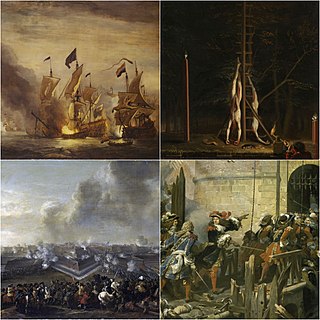
The Franco-Dutch War, also known as the Dutch War, was fought between France and the Dutch Republic, supported by its allies the Holy Roman Empire, Spain, Brandenburg-Prussia and Denmark-Norway. In its early stages, France was allied with Münster and Cologne, as well as England. The 1672 to 1674 Third Anglo-Dutch War and 1675 to 1679 Scanian War are considered related conflicts.

In Dutch history, the year 1672 is referred to as the Rampjaar. In May 1672, following the outbreak of the Franco-Dutch War and its peripheral conflict the Third Anglo-Dutch War, France, supported by Münster and Cologne, invaded and nearly overran the Dutch Republic. At the same time, it faced the threat of an English naval blockade in support of the French endeavor, though that attempt was abandoned following the Battle of Solebay. A Dutch saying coined that year describes the Dutch people as redeloos ("irrational"), its government as radeloos ("distraught"), and the country as reddeloos. The cities of the coastal provinces of Holland, Zealand and Frisia underwent a political transition: the city governments were taken over by Orangists, opposed to the republican regime of the Grand Pensionary Johan de Witt, ending the First Stadtholderless Period.

The siege of Maastricht took place from 15 to 30 June 1673 during the Franco-Dutch War of 1672 to 1678, when a French army captured the Dutch fortress of Maastricht. The city occupied a key strategic position on the Meuse river and its capture was the main French objective for 1673; it was returned to the Dutch under the terms of the 1678 Treaty of Nijmegen.
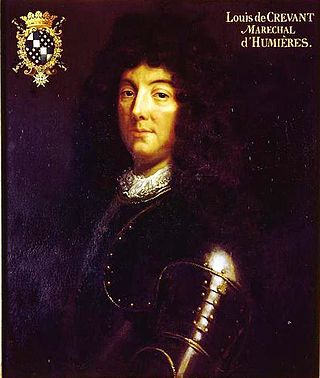
Louis de Crévant, Marquis then later duc d'Humières (1628–1694) was a French nobleman of the 17th century, who became a Marshal of France in 1668 and Grand Master of Artillery in 1685.
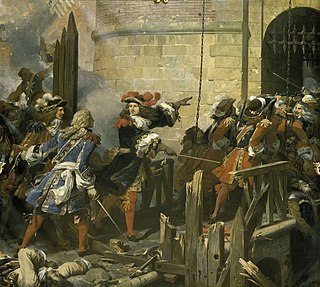
The siege of Valenciennes took place from 28 February to 17 March 1677, during the Franco-Dutch War, when Valenciennes, then in the Spanish Netherlands, was attacked by a French army under the duc de Luxembourg.

The siege of Bonn took place from 3 to 12 November 1673 in Bonn, Germany, during the Franco-Dutch War. Having forced the armies of Louis XIV to retreat, the Dutch in 1673 went on the offensive. At Bonn, a garrison consisting of troops from France and the Electorate of Cologne was besieged by a force from the Dutch Republic, the Holy Roman Empire, and Spain. The allied forces captured the garrison following a nine-day siege.

The French Royal Army was the principal land force of the Kingdom of France. It served the Bourbon dynasty from the reign of Louis XIV in the mid-17th century to that of Charles X in the 19th, with an interlude from 1792 to 1814 and another during the Hundred Days in 1815. It was permanently dissolved following the July Revolution in 1830. The French Royal Army became a model for the new regimental system that was to be imitated throughout Europe from the mid-17th century onward. It was regarded as Europe's greatest military force and the most powerful armies in the world for much of its existence.
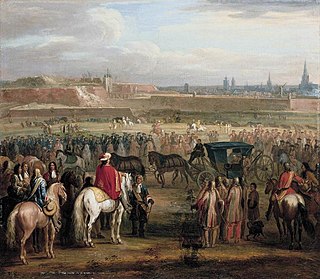
The siege of Cambrai took place from 20 March to 19 April 1677 during the 1672–1678 Franco-Dutch War; then part of the Spanish Netherlands, it was invested by a French army under the duc de Luxembourg. Siege operations were supervised by the military engineer Vauban; Louis XIV was nominally in command but played little part in operations.
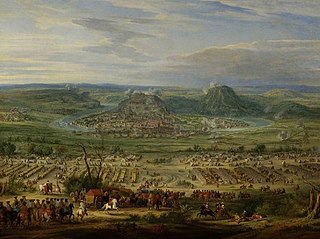
The siege of Besançon took place from 25 April to 22 May 1674 during the Franco-Dutch War, when French forces nominally led by Louis XIV of France invaded Franche-Comté, then part of the Spanish Empire.
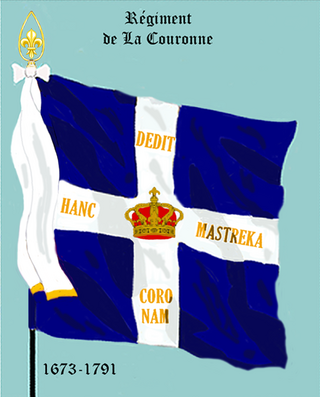
The Régiment de La Couronne was an infantry regiment of the Kingdom of France, created in 1643.
The siege of Maastricht may refer to one of several sieges:
The 1676 siege of Maastricht was a failed attempt by William III of Orange to take the city, which had been occupied by the French since 1673. The siege took place during the Franco-Dutch war of 6 July to 27 August 1676.

Charles de Montsaulnin, Comte de Montal (1619–1696) was a 17th-century French military officer and noble who was a close friend of Le Grand Condé, and fought in many of the wars of Louis XIV of France.

Claude Frederic T'Serclaes, Count of Tilly, was a soldier and later general in the Dutch States Army.

The siege of Naarden took place from 6 to 13 September 1673 during the Franco-Dutch War of 1672 to 1678, when a Dutch army captured the Dutch fortress town of Naarden. Naarden had been occupied by the French since the previous year.

The siege of Grave took place from 25 July to 27 October in 1674 during the Franco-Dutch War of 1672 to 1678, when a Dutch army captured the Dutch fortress town of Grave in what is now North Brabant. Grave had been occupied by the French since the summer of 1672 when an army under Turenne forced the town to surrender.
References
This article includes a list of general references, but it lacks sufficient corresponding inline citations .(April 2009) |
- ↑ Davis, Paul K. (2001). "Besieged: 100 Great Sieges from Jericho to Sarajevo." Oxford: Oxford University Press.